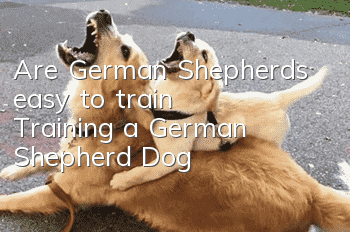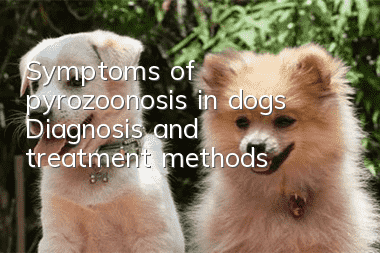Are German Shepherds easy to train? Training a German Shepherd Dog

When many people walk their dogs, they are walked by their dogs instead of actually walking their dogs. As always, they drag their owners along, so how to train them to follow their owners?
(1) Purpose requirements
Purpose: To cultivate the good habit of dogs moving side by side on the left side of the owner, so as to facilitate control and command.
Requirements: The dog should be excited and comfortable when accompanying the dog. The front of the dog's body should not exceed the shoulders, and the back should not leak. The distance between the dog and the owner should be maintained at 10 to 20 centimeters.
(2) Passwords and gestures
Password: "Fuck".
Gesture: Droop your left hand naturally and tap the outside of your left leg.
(3) Training steps and methods
The first stage: Cultivate the dog to form a basic conditioned reflex to the "fuck" command and gesture
1. Training between stops
The training content between stops includes: the owner takes one step to the right, one step forward, one step back, turn left, turn right, and turn backward.
Training method: Before the owner takes the dog into the training venue, he should first let the dog wander around and eliminate urine and feces, and then take the dog to a training venue with a quiet environment and flat ground. Hold the traction belt with your left hand about 30 centimeters away from the collar (it is suitable for easy pulling and stimulation), roll up the rest of the traction belt and hold it in your right hand, and loosen the traction belt. For example, the dog is trained to follow the owner by taking a step to the right. When the owner takes a step to the right, the command "Lean" is issued, accompanied by the stimulation of pulling the leash, forcing the dog to lean in the correct position, and then giving timely rewards. After repeated training, the dog will automatically lean on the correct position according to the "lean" command. Other content between stops is also trained in this way.
2. Training while traveling
(1) Use traction belt control. The leash grip is the same as the stop. When the owner starts to move, he gives the "lean" command at the same time, and with the stimulation of pulling the leash forward, he moves forward at a faster pace, so that the dog can lean on the correct position and follow. At the beginning of training, the dog is susceptible to external influences and is not used to it, so it is inevitable that it will deviate from the correct position. When this situation is discovered, the "reliance" command should be issued immediately, accompanied by the stimulation of pulling the leash, so that the dog can return to the correct position, and then be rewarded in time.
(2) Use reward food or objects to induce and combine with leash control. Holding the reward food in the left hand and the leash in the right hand, the owner gives the command "reliance" and moves forward. In order to obtain the reward food, the dog can easily follow the owner's intention and maintain the correct follow-up action. At this time, the owner should move the reward in the left hand. Reward the dog with food in time, and then take out a piece of reward food to continue training. If the dog makes a wrong move, you should immediatelyNow give the command "reliance", and at the same time hold the traction belt in your right hand to give appropriate stimulation to prompt it to return to the correct position, and then reward it in time.
The second stage: the complication stage of conditioned reflex
1. Change of pace and direction
Pace change refers to the mutual transformation between fast walking, slow walking and running, so that the dog can synchronize with the owner. At the same time, the dog must also adapt to the direction change between traveling. Direction change refers to turning left, turning right and turning backward while traveling. When training, you should pay attention to giving the "lean" command and gesture in advance whenever you change pace or direction, and gently pull the leash to signal the dog to prevent the dog from deviating from its position. When the pace and direction change, reward the dog in time. In this training, the "reliance" command cannot make the dog distinguish which direction to turn, or speed up or slow down. It can only use the owner's movement rhythm changes as the dog's signal. Every human movement has a pre-rhythm, a main rhythm, and a post-rhythm. Dogs often respond to the pre-rhythm of their owner's movements.
2. Take off the rope and go with you
The training of leash-free walking starts with the proficiency of pulling and walking. The first step is to loosen the leash so that it does not have a controlling effect. When the dog leaves the correct position, use commands and gestures to command it to return. If it still doesn't work, immediately pull and correct it to the correct position. After training, if the dog can maintain the correct following for a long distance, the second step can be to drag the leash on the ground and let the dog follow. After a period of training and the dog becomes more proficient, the third step is to remove the leash and let the dog follow. But the method of taking off the rope should not be sudden, but in the process of dragging the rope, so that the dog can unknowingly untie it. If the dog follows correctly, it should be rewarded in time. If the dog deviates, it should be corrected in time. If the dog does not obey the command, it should be pulled and trained immediately. Do not let it move freely. When the dog can obey the command and follow correctly, the traction training can be released. Repeat this until the requirements are met.
The third stage: Exercise in complex environment
When training in a complex environment, you should decide whether to use traction control based on the specific situation. When the dog is affected by novel stimuli and delays its actions or does not execute the command, it can issue a command with a threatening tone, accompanied by the stimulation of jerking the leash, to force the dog to follow it correctly. In places where pedestrians and vehicles are densely packed, the vehicle should be towed to prevent accidents.
In addition to being carried out specifically, this training can also be carried out in combination with daily relaxation and training in other subjects.
This subject is considered completed when the dog can obey the owner's command and can always follow the owner's left side correctly without pulling under relatively complex environmental conditions. But review and consolidate frequently.
(4) Issues that should be paid attention to during training
1. Since the training content between stops is all carried out in place, it is relatively monotonous., it is easy to inhibit the dog. Therefore, the dog's excitability should be adjusted well, and training should be combined with walking.
2. In the early stage of training for this subject, which is the stage of establishing basic conditioned reflexes for commands and gestures, commands should not be too frequent. Commands should only be issued in time when the dog makes a wrong move, accompanied by the stimulation of pulling on the leash.
3. The leash should be used flexibly. Firstly, it should not entangle the dog's movements; secondly, it should not be pulled very tightly all the time, not giving the dog a chance to move freely. It should be loose and tight, flexible and moderate.
4. Follow-up training must be closely integrated with daily management. Even in daily management, dogs cannot be left alone.
- Why do pets smell bad? Is it helpful to use Aineng pet deodorant?
- How to induce vomiting and first aid for dogs after swallowing poison?
- How to choose golden retriever dog food? What should you pay attention to when feeding golden retrievers?
- What are the symptoms of canine distemper in dogs?
- The role of dog probiotics
- Symptoms of water poisoning in dogs
- Symptoms of bad health in dogs
- Advantages and Disadvantages of Neutering Female Dogs
- What should I do if my puppy suffocates after birth?
- Tips for buying purebred Chihuahuas



